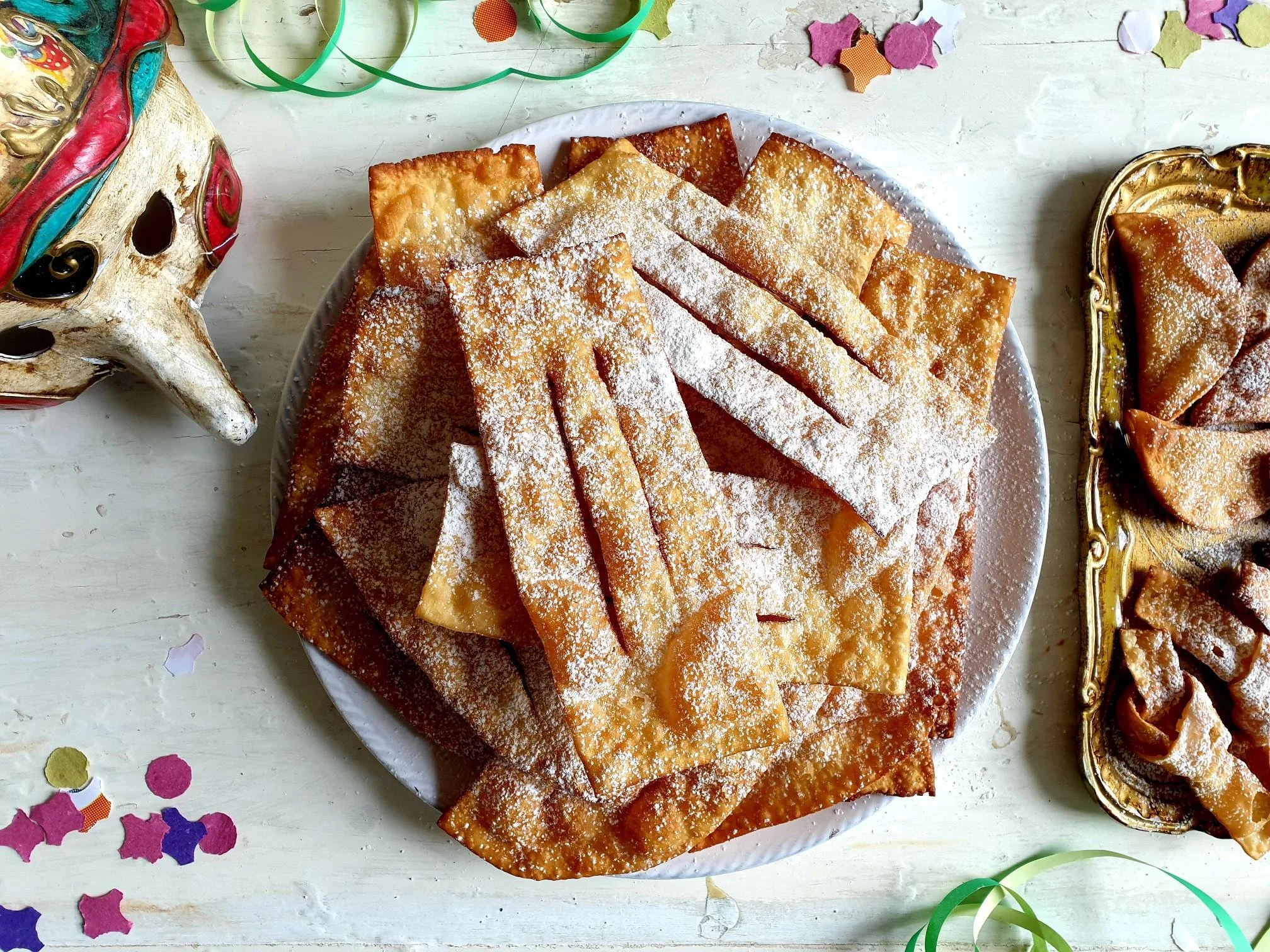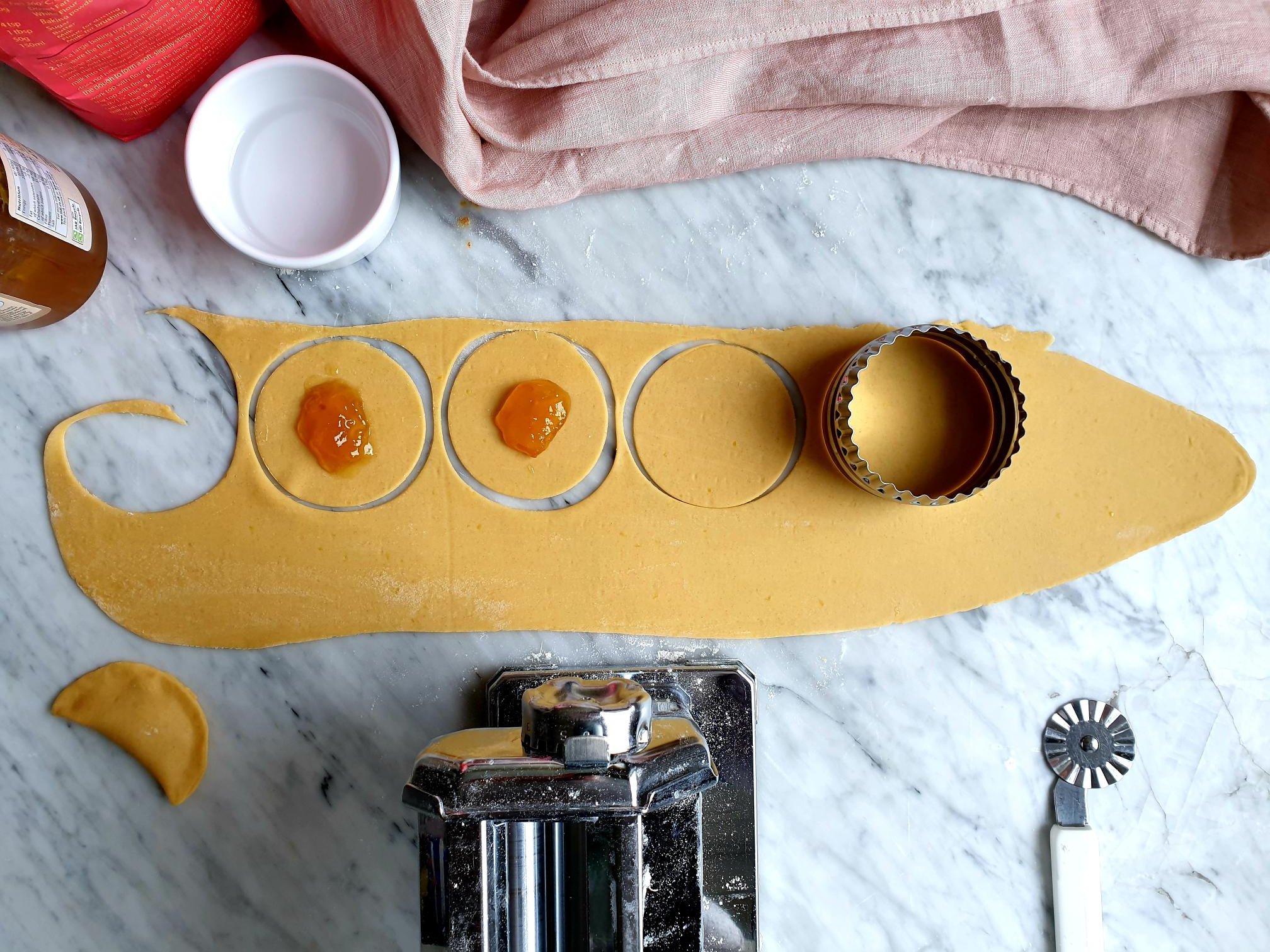Carnival Sweet Crackers Istrian Recipe
These delicate, fragile, irresistible and crispy pastries are traditionally associated with Carnival (Pust in Slovenian), and they are super tasty, so light and flaky that they just simply melt in your mouth.
They have a deep connection with Christian, especially Catholic, liturgical festivities like the Carnival season, the time of the year in which eating in excess, and gastronomic indulgence was allowed by the Church before the start of fasting and austerity during Lent, culminating with the Easter celebrations.
To make this crumbly sweet dessert is very easy, sweet dough is rolled out very thinly, it then gets very quickly fried, and it is during the frying process that this wafer thin rectangles of pastry contort into the strangest shapes. When they cool down completely they get covered in a generous dusting of icing sugar to delight children and grown-ups alike.
Together with fritole and jam filled doughnuts they are a very common sight in the pastry shop windows offering to by-passers a very cheerful Carnival atmosphere.
There are many different names for these sweet wafer-like treats throughout Italy, bugie in Piedmont, frappe or sfrappole in Emilia, cenci and donzelle in Tuscany, chiacchiere and lattughe in Lombardy to name just a few.
It is believed that they originated in the region of Veneto, where they are known as Galani or Crostoli, although their origin is being disputed and other Italian regions have claimed the credit for them.
On the coastal part of Slovenian Istra, once being part of what was called, “The most Serene Republic of Venice,” these sinfully delicious and and fragrant little delights are almost a symbol of the Carnival season, and are called, and known by the locals as hroštole, hroštule or krhki flancati in standard Slovenian.
Traditionally, they are made in quite large quantities as they are meant to last for the whole period of Lent, you will find them in rectangular shapes, but the strips of dough can be cut in different shapes like diamonds or squares, you can cut thinner strips and make knots (bows) or create rafioi (or rafioji) folded like ravioli biscuits that use jam or preserve as a filling.
These sweet Carnival temptations have been part of my life. My nona used to make them every year in huge quantities, and I am sharing here her recipe, and her little secret, she adds a bit of single cream to the dough mixture...
Recipe
Ingredients
250g all purpose flour (white plain flour)
3 egg yolks (room temperature), lightly beaten
2 Tbsp milk
3 Tbsp dark rum or grappa (can use Marsala, brandy or similar)
finely grated lemon zest of 1 unwaxed lemon
2Tbsp lemon juice
50g sugar (caster or granulated)
pinch of sea salt
vanilla icing sugar or plain icing sugar, for dusting, to serve
oil for frying
Method
Sift the flour in a fairly large mixing bowl and add lightly beaten egg yolks, milk, rum or grappa, finely grated lemon zest, lemon juice, sugar and a pinch of sea salt.
Mix well with the fork to incorporate all the ingredients, then gather with your hands to form a fairly firm dough.
Adjust the wetness of the dough by either adding a little flour at the time if the dough is too wet, and on the contrary, gradually adding a bit of milk if the dough is too dry.
Transfer the dough onto a working surface and work the pastry mix quite intensely for about 10-15 minutes. You should end up with a smooth and elastic dough that does not stick to your hands or the surface, it should be firm, bur fairly soft to the touch.
Shape it into a ball and wrap in cling film and leave it to rest at room temperature for at least 30 minutes, ideally about 1 hour.
Divide the dough into smaller portions (about 150g).
If you have a pasta machine, this is the time to use it, alternatively a rolling pin will do the job just fine.
With the palm of your hand flatten slightly the first portion of the dough.
Sprinkle with a little bit of flour and roll it out with the pasta machine to the widest thickness.
Fold the short sides of the sheet of dough towards the centre.
Continue to roll the sheet of dough using an increasingly thinner setting on the pasta machine each time.
Stop rolling when you reach the last and the thinnest setting, and the dough sheet reaches the thickness of about 2mm.
Repeat the process with the remaining portions of the dough.
If you are using rolling pin, roll each portion of the dough to the thickness of a coin, roughly 2mm.
Using a knife or a pastry (cutting) wheel, cut the rolled sheets of dough into rectangles (about 5 x 10 or 2-inch x 4-inch).
Make a couple of incisions in the middle of each strip (parallel to the long side on each one).
This will help the sweet crackers to expand during frying.
Strips of dough can be cut in different shapes, you can cut thinner strips and make knots (bows).
You can also create rafioi (or rafioji) folded like ravioli biscuits (to make these, you do not want your pastry to be rolled out too thin). Cut out circles (size of your preference). Place a dab of jam or preserve of your choice in the centre of each circle, fold in half. Pinch well to close and fry.
Heat the oil in a frying pan, bring it to the temperature of 170° C.
When the oil reaches the right temperature, place 2-3 (this will depend on the size of your frying pan) rectangles of the dough into the oil.
Fry them turning them on both sides until they are golden brown.
With the help of slotted spoon or a skimmer remove the crackers.
Place them on a tray or a big plate previously lined with kitchen paper allowing to drain.
Allow to cool completely, sprinkle with plenty of icing sugar.
Pile them in criss-cross layers on a plate and serve.
They are very fragile so be careful not to break them.
And be mindful of the fact that when you eat them you will be, almost inevitably, covered slightly in a bit of crumbs and icing sugar, is all part of the experience, it is Carnival after all!
Just a thought
These sweet Carnival crackers are best enjoyed as soon as they are made.
They can be stored for about 2-3 days in an airtight containers.






























